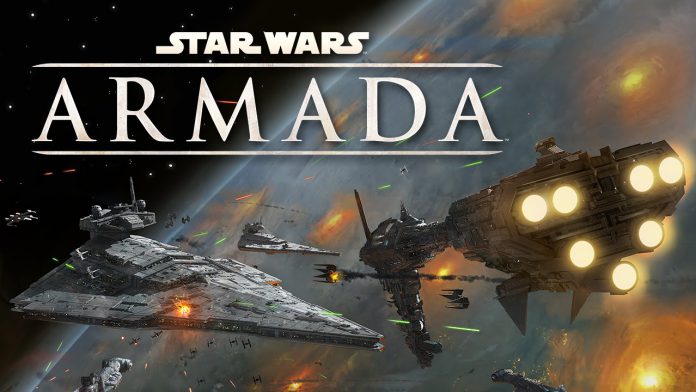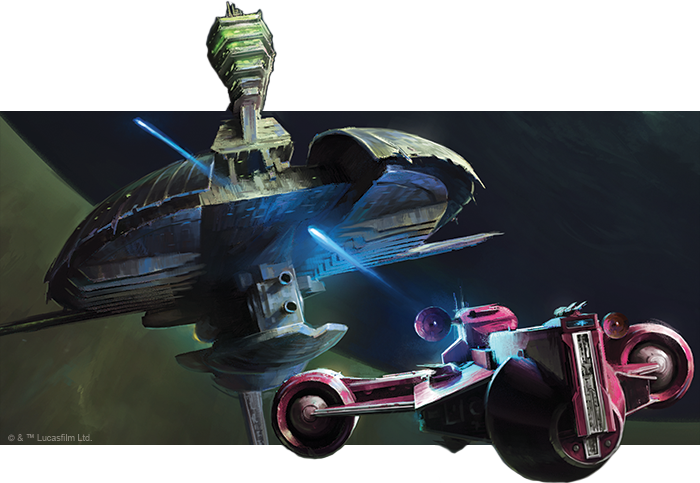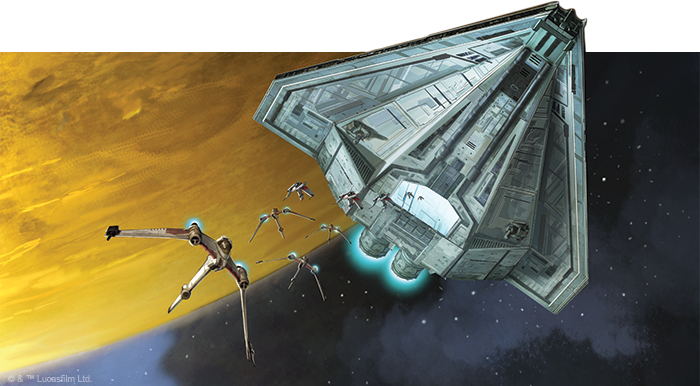Welcome back to our regular coverage of Star Wars: Armada. If you missed our article on getting started, you can find it here.
I’m back with another Armada faction focus. It’s time to respond to the droid attack on the Wookiees.
Death and Taxes – “The day we stop believing democracy can work is the day we lose it.”
The Galactic Republic is a democratic alliance of countless systems and species united in a galaxy-spanning organisation. For millennia, it was the galaxy’s largest political body and responded to day-to-day problems and galactic threats alike. It reached its height in the centuries before the Clone Wars, which toppled it. In its wake, it was replaced by the Galactic Empire, until the Alliance to Restore the Republic overthrew that. Despite this reformation, the Republic’s millennia-long streak of dominance had come to an end, and the New Republic took its place.
In Armada – “Rule #45, Sev: ‘Any crash you can walk away from is a good one.’”
Star Wars: Armada showcases the Republic at its height: the Grand Army of the Republic (GAR) has cut its teeth after Geonosis and fields a capable navy staffed by veteran clones. This redoubtable force is backed by an array of Jedi in command and support positions alike. The Republic’s capital ships behave similarly to their Imperial successors: durable and hard-hitting.Their ships are defensively balanced, boasting sturdy shields, sturdy hulls and a diverse range of defence tokens. Republic ships favour frontal firepower, and feature universally good speed values, but their larger ships handle like bricks when pushed that far. They are backed by elite squadrons and their Jedi allies. This provides a brutal, if extremely costly adjunct to your fleet. They benefit from coordination and patient command. Many of their force multipliers further encourage a steady playstyle.
The characteristics of the Galactic Republic in Armada are:
- High top speed, workable manoeuvrability
- Well-balanced defences, but no duplicate defence tokens
- Strong forward-facing firepower
- Small, but incredibly strong and versatile ship roster
- Small, elite squadron roster with Jedi aces
- No Ion Cannon upgrade slots
Commanding the Republic – “Oh, no. I’m not brave enough for politics.”
The first and most important thing about the Republic is coordination. They lack the knockout-capability or flexibility of other factions, but have an array of tools that promote mutual support. The faction’s notable lack of Ion Cannon upgrade slots also limits their ability to control dice, due to the common use of Ion Cannons to fix dice. Consequently, the Republic is very reliant on other forms of dice control. They are a uniquely token-hungry faction and demand command tokens to power up unique upgrades and generic support upgrades alike.
The fleet itself is marvellous. The Clone Wars factions were released with over half a decade of game design experience and represent tight rosters of well-designed (if very powerful) ships that took lessons from each preceding expansion. The Clone Wars factions were the first to make full use of Salvo tokens, and this powerful token is standard on their large and medium ships. The downside is that Republic defence tokens jostle for space – the faction has no duplicate defence tokens on any ships, making them vulnerable to failure once tokens are locked down or discarded. Their ships are well-balanced between hull HP and shields, with no particular bias in either direction. Speed is good, with only the Pelta trailing at Speed 2, but their turning at top speeds is universally bad.
The Republic ship roster is tiny, and makes up for it in cost-effectiveness and versatility. The Venator is a capable command ship, an artillery ship and possibly the game’s best battlecarrier. The Acclamator is a potent carrier and combatant with plenty of upgrade options. Rapid Reinforcements I gave them another artillery and close assault ship in the Victory I. In the Consular variants, you have skirmishers, attack ships, and fleet support. These roles are spread over several ships in most factions. Lastly, the Pelta rounds out the roster as a dedicated support vessel. Fleets of the Galactic Republic live and die by good fleet-building and teamwork, exactly as you’d expect from a highly disciplined and advanced fighting force.
The Republic commander roster is small and capable. 2 defence token-oriented commanders (Obi-Wan Kenobi, Luminara Unduli); 2 squadron commanders (Plo Koon, Admiral Yularen and 2 command manipulation commanders (Admiral Tarkin, Bail Organa). They have an especially high ratio of dedicated squadron commanders and Bail, who greatly benefits squadron-heavy fleets. It’s no mistake that half of their commanders and nearly half of their ships play well in carrier fleets. A Republic fleet is often strongest when supported by squadrons – their ships have neither the firepower to obliterate an enemy fleet on contact, nor the extraordinary durability to outlast enemy combatants. Using squadrons to screen for the fleet and soften enemies up is extremely prudent.
The characteristics of their ships hold true elsewhere: the Republic has few squadrons, but they are powerful, expensive and have great support tools. Their generic squadrons present powerful variations on classic concepts like fighter escorts, fighter-bombers and interceptors. Average speed for their squadrons is sub-par. They don’t have any squadrons that hit the Speed 5 maximum and the ARC-170 sits in the slowest speed bracket. Fortunately, tools like the aforementioned Hyperspace Rings greatly address this. Their solid generic squadrons are supported by clone aces and Jedi, and Republic aces often provide potent area effect buffs. Jedi aces piloting the Delta-7 benefit from strong keywords and special abilities. Even Republic squadron aces prioritise good cohesion and team play, preferring to fly beside their clone allies rather than ahead of them (Anakin in a Delta-7 being a notable exception).

I love the Republic (and its democracy). Episode II was my first Star Wars movie, and the sight of clone legions marching onto Acclamators was forever burned into my mind. Their fleet in Armada plays exactly as you’d want it to: a disciplined, high-tech army supported by the finest Jedi minds of its era. I typically don’t recommend Clone Wars factions to new players, since they have in-built downsides (no Ion Cannons, AI squadrons) and complex rules that throw new players off. I still haven’t figured out what Tikkes does. However, the faction is undeniably tasty in lore and models. To command Republic fleets to their potential, players must understand fleet-building with limited options, fly squadrons smartly, and learn positioning and token manipulation. Those who master it will experience an Admiral Thrawn-esque smugness of watching a complex plan come together before them. Those who don’t, go to Discord and complain about how weak the Consular is.
Key requirements for playing the Galactic Republic to its full potential are:
- Building fleets from a limited selection of ships and squadrons
- Flying ships in a mutually supportive manner
- Coordinating squadrons and carriers effectively
- Understanding when to stand, and when to escape
- Balancing your flexible, but limited defence tokens
Strong picks
Ships
Consular-class Cruiser
The Phantom Menace accurately depicts what happens to a Consular at Speed 0: an explosion. This light cruiser is the Republic’s light combat ship and comes in two hull variants: the Armed Cruiser, an attack ship; and the Charger c70, a skirmisher. The naming is counter-intuitive. The Cruiser is geared toward punching with External Racks and leaving quickly. Meanwhile, the Charger’s longer range makes it suited to cheap skirmishing like the Rebel CR90 or Imperial Arquitens. Chargers pair especially well with Swift Return to keep the guns on target. Rounding out this selection of roles is Radiant VII, which converts the ship into a fleet support vessel at the expense of your combat capabilities. Goes great with Munitions Resupply, or your pick of Fleet Support upgrade. In the Rebel and Imperial fleets, this role belongs to flotillas, but Clone Wars fleets mount fleet support upgrades onto fighting ships to keep things spicy. The Consular is a great, multi-role small ship that behaves like three ships in one hull. It just folds under sustained firepower.
Acclamator-class Assault Ship
When it was previewed, players quickly realised that the Acclamator is what the Victory-class wishes it could be. This is a chunky medium ship adept at providing carrier support, escorting larger ships or fighting on the line. The hull is also affordable enough to be a viable pick without compromising the rest of your fleet – a sentence brought to you by Victory-class fans weeping in the corner. The basic Acclamator is built as a I-class carrier using the marvellous Nevoota Bee, or built as a close-ranged combatant. Carriers are often seen with the classic Expanded Hangar Bay, plus a Flight Commander for aggressive play. Combatants receive range-appropriate options to support their role of punching someone in the face or dice control. The II-variant is a proper gunboat and it benefits from an extra front die and a defensive retrofit, but sacrifices the support options provided by its cheaper sibling. No matter the fitting, this is a well-rounded frontline vessel that sees constant use.
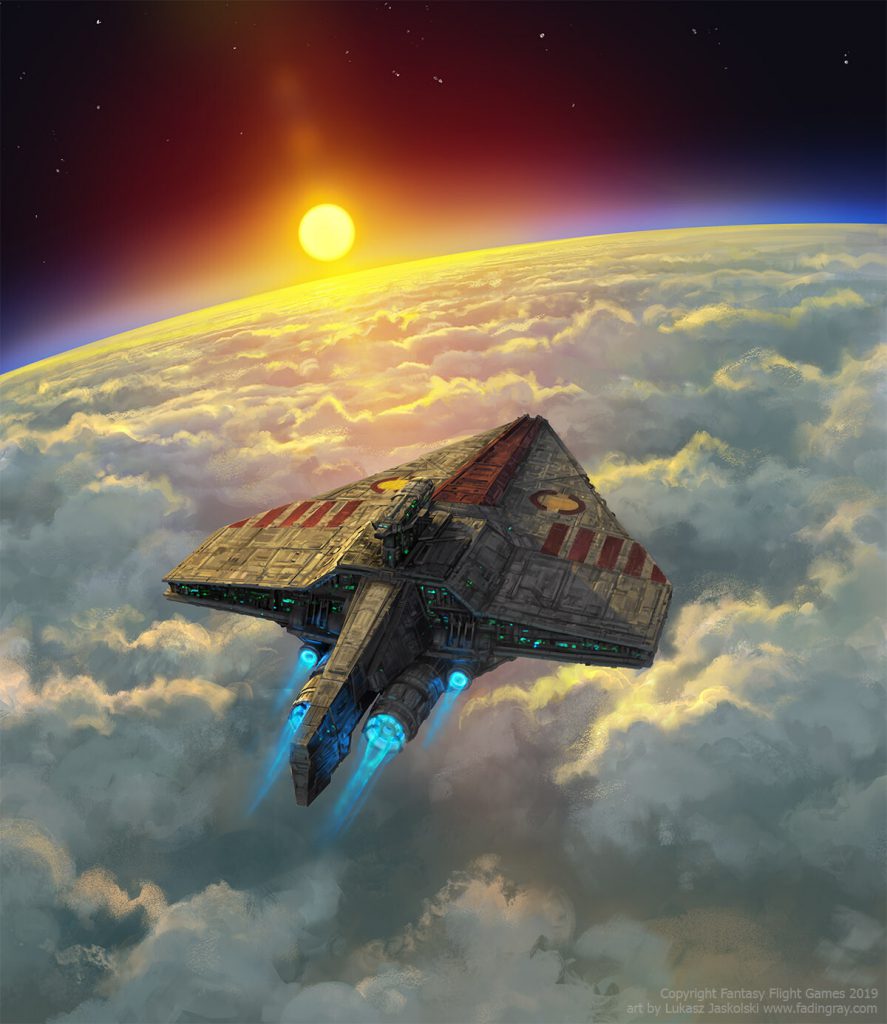
Venator-class Star Destroyer
The good guy Star Destroyer: sleek, versatile and capable. Venators anchor the Republic fleet with a well-rounded large-base ship. Although it resembles an Imperial-class Star Destroyer, it lacks the raw brutishness of its Imperial counterpart. A more elegant weapon for a more civilised age, if you will. Its strength lies in versatility: it plays well with most of the Republic’s commanders and can be fitted as a carrier, combatant, or artillery ship. It gives the Republic their only native Fleet Command slot. Quantitatively, it is robust and can pull off a good top speed. It hits hard enough, but cannot deliver brutal up-front damage on its own. Instead, take the Venator II and build an outstanding battlecarrier, or wield the Venator I as a robust Salvo based flagship. Just don’t go swinging head-on with an angry Kuat Refit Star Destroyer, or fight an MC80 commanded by Kyrsta Agate and expect a happy landing.
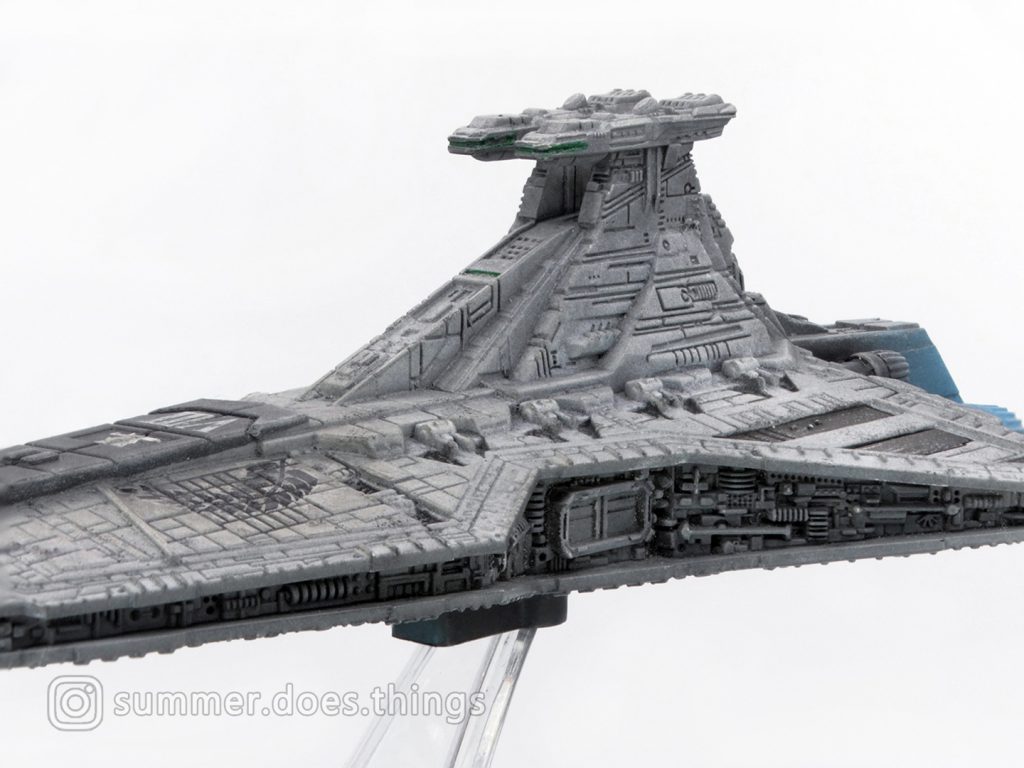
Squadrons
Plo Koon and Luminara Unduli (Delta-7 Aethersprite Squadron)
These two Jedi form the basis of many Republic squadron groups. Both characters have the brutal Scatter + Brace token suite and area-of-effect buffs that target generic squadrons. Plo Koon is more limited, and his ability is essentially restricted to V-19 Torrents and BTL-B Y-Wings. V-19s should be your first pick for a squadron group supported by these two because they provide the Escort keyword that shields them from enemy squadrons. A squadron complement containing these two Jedi and a cluster of V-19s is extremely difficult to shift.
Kit Fisto (Delta-7 Aethersprite Squadron)
Kit Fisto’s a nightmare to kill: he can discard either of his two defence tokens to reduce incoming damage by 3 (he has 4 HP). Even though he’s less support-oriented than other squadrons in the Republic selection, he provides Intel. Post-nerf Intel still has use and placing it on a strong ace is a good way to get a crucial squadron into a superior position. It’s the last keyword on a very busy card, so try not to forget it.
V-19 Torrent
The Torrent is an honest mule that carries your squadrons on its back while asking no thanks in return. Torrents are the ‘basic’ Republic squadron. They’re more potent than lower quality adversaries, and not as versatile as the infamous X-Wing. It’s an escort fighter for 12 points, but what a package. V-19s are durable, fast enough to escort anything that needs the help and benefit from numerous powerful buffs. The strength of Torrents doesn’t lie in their individual capability, but in the support structure around them. Everything from Nevoota Bee to Luminara Unduli is here to make them better. They’re the core of a Republic squadron group.

Honourable Mention: ARC-170
I think it’s the coolest of the whole lot personally. It’s highly impractical for an navy that is always outnumbered to have a three seat fighter-bomber, but what a great design. What a lovely hunk of WWII heavy fighter in space. ARC-170s are an X-wing married to uncompromising aggression and unity of purpose. Key differences include extra durability, a bit less anti-squadron firepower and Counter to represent that rear-facing cannon. They seem like a perfect package, if not for their worst-in-class speed value: of 2. ARC-170s can be absolutely lethal, but they’re not part of your main squadron group at deployment. They move too slowly to get into battle on their own and need some help. Hyperspace Rings were basically made for this squadron, so use them to jump your ARCs ahead of the main force and let the escorts catch up.
Upgrades
Clone Captain Silver
Silver lets his ship perform an extreme speed change, at the expense of not being able to use a Navigate command during that ship’s activation. This pairs well with any ship that might need an aggressive speed change to: escape combat (External Racks Acclamator); to rush a destination (Mercy Mission Consular); or stay in combat and then escape at full speed (DBY-827 Venator). Silver is most useful on ships with a wide Speed chart, which excludes the sluggish Pelta. The ability to get up to 3 Navigate tokens of value out of a refreshable card is pretty impressive.
Clone Captain Zak
Zak adds dice to his ship’s attacks, which is always a prized ability. He’s limited to side and rear arc attacks and eventually needs to be refreshed with Concentrate Fire tokens. You get two uses of his ability (readied at start and the token his card comes with) before he needs a new token to refresh. His value is that for a few points, he gives what amounts two Concentrate Fire dials for attacks from the side and can obtain even more if you feed him some tokens. As per his depiction in The Clone Wars, he pairs best with the Consular and its generous side arcs. Larger ships like the Acclamator or Venator have their own officer preferences and benefit less from a single extra die due to their large base dice pools.
Nevoota Bee
This Acclamator title is the default pick for carrier builds. Of all factions, the Galactic Republic gets some of the best value from generic squadrons due to all of their buffs they can hand out (like the aforementioned Plo Koon and Luminara Unduli). Nevoota Bee continues that tradition by giving generic squadrons it activates Swarm. Swarm is a simple, but useful one-die reroll against enemy squadrons. Perfectly good. Of course, its second ability is that each Swarm squadron it activates gets the re-roll when attacking ships, too. Squadrons that would otherwise be impotent against ships are suddenly able to amass horrifying amounts of chip damage to ships, and the value is not lost on bombers fishing for critical hits, either.
Thermal Shields
This card is an incorrigible mess, and I’ll leave its explanation to the fine people at Cannot Get Your Ship Out. The abridged version is that after your opponent gathers their dice for an attack, you can spend a Brace token to pluck half of those dice out of their hand (rounding down). The strengths of Thermal Shields are they don’t need to refresh and open up interesting tactical opportunities. Their key capability is that they take the momentum out of dice-heavy attackers like Imperial Star Destroyers, and can selectively remove high-threat dice from the pool – black dice and dice that correspond to critical effects come to mind. This card is a bit dependent on the opponent, though. It’s most powerful when used in a setting where opponents bring ships with high base attack values, while failing miserably against attackers that add dice after the initial roll. When it hits the niche it was made for, it’s a nightmare for your opponent. When it misses the mark, you’ll wish for Electronic Countermeasures instead.
Fleet building pointers for the Galactic Republic:
- Republic fleets are starved for two things: tokens and dice mitigation. These often go hand–in–hand. Build your fleet around support assets or a plan to generate the necessary tokens to get the consistency you need to stand toe-to-toe with other factions. If you don’t, you’ll be left wondering what’s wrong with your ships today.
- Clone Wars-era factions are more reliant on squadrons than their Galactic Civil War counterparts. Their fleets are blessed with good squadron values, powerful buffs and generic squadrons that benefit greatly from support. Even a token Republic fighter screen can bog down enemies and you have the tools to make them shine.
- Republic ships benefit from diverse token suites and generous access to Salvo. Without duplicate defence tokens, their ships are typically less durable than their counterparts, especially when you consider that Salvo only works if you’re being shot. They’re well-rounded ships, but are not bruisers and will need to leverage speed or defensive upgrades to stay alive.
Conclusion – “This is a relief mission.”
There’s a lot to be said for a faction that amounts to Galactic Empire, but beautiful and noble. The Republic brings a well-rounded faction filled with the best of the prequel-era’s ships. Being one of the newest and smallest factions, Armada players are still grappling with the details of their use, but balance is the key. The Republic lacks any defining strengths and is built on teamwork and clone blood. I love the clones and the flawed democracy they fought for, and I’ll defend the Venator until the day I die.
Have any questions or feedback? Drop us a note in the comments below or email us at contact@goonhammer.com.
